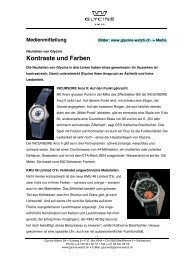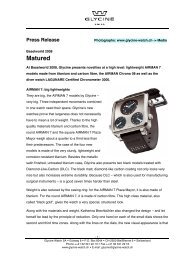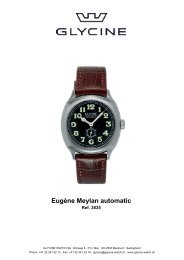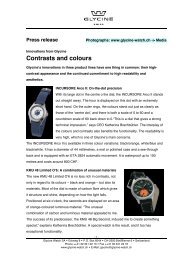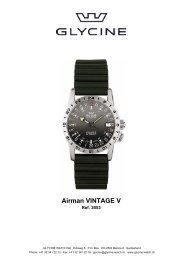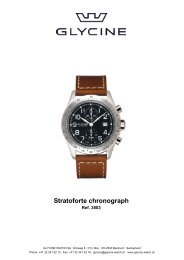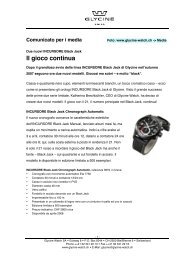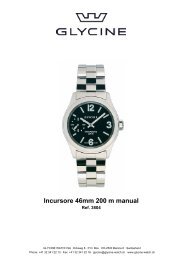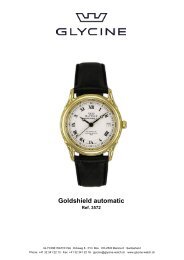Untitled - Glycine Watch SA
Untitled - Glycine Watch SA
Untitled - Glycine Watch SA
Create successful ePaper yourself
Turn your PDF publications into a flip-book with our unique Google optimized e-Paper software.
MES<strong>SA</strong>GE FROM THE PRESIDENT<br />
From its founding by Eugene Meylan in 1914, <strong>Glycine</strong><br />
has continuously produced fine watches at its factory in<br />
Bienne, Switzerland.<br />
Meylan was an uncompromising watch engineer who strived<br />
for perfection and nothing less. He possessed a profound<br />
understanding of both the demands of the marketplace and<br />
the great possibilities offered by the technological advances<br />
of his era.<br />
Nearly a century has passed since the founding and 99<br />
years after the creation of his first <strong>Glycine</strong> watch, Meylan’s<br />
spirit lives on! <strong>Glycine</strong>, more than ever, burns its own trail by<br />
creating distinctive timepieces predicated upon the unique<br />
DNA developed by Meylan, always a bit outside of the<br />
mainstream.<br />
Today, <strong>Glycine</strong> is recognized as one of the real pioneers<br />
for world timer and aviation watches as well as high quality<br />
watches of imposing size and design.<br />
Since its founding in 1914 by Eugene Meylan, <strong>Glycine</strong> has<br />
remained a Swiss family owned and managed company,<br />
which is today managed by its owner Stephan Lack.<br />
Stephan Lack President<br />
2
THE BEGINNING : THE HISTORY OF A PASSION<br />
Meylan was an uncompromising watch engineer who<br />
strove for perfection and nothing less. He had a profound<br />
understanding of both the market demands and the<br />
possibilities offered by the technological advances of the<br />
time. Very soon, he succeeded in producing extremely<br />
precise, small movements for ladies watches, enabling<br />
<strong>Glycine</strong> to put on the market the finest miniature<br />
movements, clad in precious gold and platinum cases,<br />
often studded with diamonds.<br />
<strong>Glycine</strong> became a supplier to the wealthy people who valued<br />
highly these works of fine craftsmanship. However, Meylan<br />
did not stop there. Around 1931, he presented to the world<br />
market a well-functioning self-winding watch, entirely of his<br />
own invention, a sensational performance that, for lack of<br />
capital, could not be exploited commercially. Some of these<br />
GLYCINE Eugène Meylan <strong>SA</strong> self-winding watches can still be<br />
found in the collectors’ market.<br />
The year 1934 saw the launch of a chronometer range, a line<br />
of watches passing the exacting tests of the Official Swiss<br />
Quality Control. The depression years of the 30s and the<br />
approaching world war took a heavy toll on the company as<br />
Switzerland was cut off from nearly all its traditional export<br />
markets.<br />
Yet <strong>Glycine</strong> survived and even managed to be one of only 29<br />
exhibitors at the Basel Fair in 1938, an annual event the firm<br />
has not missed since.<br />
3
In 1945, with the war over and access to world markets<br />
again possible, the industry took a deep breath.<br />
Immediately, <strong>Glycine</strong> geared up production and rapidly<br />
presented a complete range of automatic (self-winding)<br />
watches, making use of the most advanced technologies.<br />
AFTER WORLD WAR II<br />
1952 saw the birth of the famous VACUUM chronometers,<br />
watches known for their incredible resistance to water and<br />
shocks, designed for long-term use under hostile conditions.<br />
They performed well beyond expectations.<br />
In 1953, the AIRMAN line was presented to the world market<br />
and immediately received an enthusiastic welcome. Now, in<br />
addition to regular local time, world time was available at a<br />
glance.<br />
The steadily growing class of jet-setters and frequent<br />
travellers readily took to the convenience of having two time<br />
zones on their wrist.<br />
The AIRMAN line has never been absent from the <strong>Glycine</strong><br />
selection, and is, today more than ever, the spearhead of the<br />
range.<br />
4
THE CRISIS<br />
In the 70s, the Swiss watch industry – late in introducing<br />
quartz movements - was hit by the proliferation of quartz<br />
watches from the Far East<br />
The technological revolution brought about by the quartz<br />
movement, together with the world-wide recession and a<br />
massive increase in value of the Swiss franc, pushed many<br />
manufacturers to the brink of disaster.<br />
The products that had earned <strong>Glycine</strong> such an excellent<br />
reputation, namely high-quality mechanical watches and<br />
above all automatic watches, were suddenly no longer<br />
in general demand. Customers everywhere were buying<br />
Japanese quartz watches or American digital LED watches.<br />
The lucrative business with highly-regarded automatic<br />
watches was over, and these were now being sold off at giveaway<br />
prices.<br />
The market went through a turnaround in its values, a<br />
tendency which further intensified as the price for the initially<br />
exorbitantly expensive quartz watches consistently dropped<br />
to a level where it finally drove even the cheap pin-pallet<br />
(Roskopf) mechanical movements out of the market. Many<br />
market shares were lost, the industry entered into a crisis that<br />
lasted six years and cost roughly 60,000 jobs.<br />
<strong>Glycine</strong> too suffered heavily but managed to survive. In 1984,<br />
soldering on with a reduced staff, <strong>Glycine</strong> was sold to Hans<br />
Brechbühler, who had been working for years with <strong>Glycine</strong><br />
in a loose cooperation based on the joint development and<br />
exchange of watch models.<br />
5
THE COMEBACK<br />
Progressively, new products were developed that<br />
enabled <strong>Glycine</strong> to work successfully in countries such as<br />
Scandinavia, Italy, Holland, Belgium and Germany.<br />
A quartz collection was created and an international network<br />
of agencies sprang to life again. Extremely resistant watches,<br />
such as the TJALK and HEAVY DUTY models, were launched<br />
and added to the prestige of the brand.<br />
The market accepted with pleasure the GOLDSHIELD line,<br />
featuring a standard of goldplating much higher than anything<br />
the competitors could present. The sophisticated super-thin<br />
AMARANTH watches received an enthusiastic welcome in<br />
Italy and the U<strong>SA</strong>.<br />
The new strategies began to pay off in the early 1990s<br />
when <strong>Glycine</strong> implemented a new brand concept, resulting<br />
in mechanical products being increasingly integrated into<br />
the company’s collections. This strategy proved effective in<br />
positioning <strong>Glycine</strong> as a specialist, with a long tradition in the<br />
field of mechanical watches.<br />
After an initial success in Germany, the first to really accept the<br />
mechanical watches on a large scale, the new range of <strong>Glycine</strong><br />
products spread to other countries.<br />
6
MECHANICS IN THE ASCENDANT, THE GIANTS TAKE OVER<br />
The markets were now ready for watches of real value,<br />
and <strong>Glycine</strong> made the most of it.<br />
Beginning in the late 90s and in quick succession, a rich<br />
assortment of mechanical watches, with steadily growing<br />
diameters, was presented to the market, from the 37 mm<br />
COMBAT to the 42 mm OBSERVER, the 44 and 46 mm<br />
INCURSORE, the 48 mm KMU and, to top it off, the 52 mm F<br />
104, one of the biggest wrist watches ever produced.<br />
Chronographs with the famous V 7750 and 7751 movements<br />
were added, such as the classic 46 mm STRATOFORTE, the<br />
giant GRAND CARRE 3810 and the elegant barrel-shaped<br />
ALTUS, inspired by a successful <strong>Glycine</strong> model of the 50s.<br />
All these big size watches gave the company the status of a<br />
daring innovator that did not hesitate to push the size of its<br />
watches beyond every dimension known so far.<br />
7
AIRMAN FOREVER<br />
Already in 1953, <strong>Glycine</strong> started production of its first<br />
Airman model, a watch that has become legendary. The<br />
design and features of this watch had been worked out in<br />
close co-operation with pilots of civil and military aviation.<br />
Undoubtedly this line gave <strong>Glycine</strong> the status of a pioneer in<br />
the field of world time watches. Over the years Airman models<br />
have never been absent from the <strong>Glycine</strong> range, even during<br />
the period when quartz movements dominated the world<br />
market. In reply to market demand, two AIRMAN models with<br />
ETA quartz movements were launched, gaining particular<br />
success in Japan and U<strong>SA</strong>, where demand for real world time<br />
watches had not faded.<br />
The year 1998 brought the long-awaited rebirth of this leader,<br />
with model ref. 3764, AIRMAN 2000. By using an exquisite<br />
ETA movement 2893-2, <strong>Glycine</strong> offered a three-time-zone<br />
timekeeper, unique in the field of 24-hour watches. The<br />
following year, the AIRMAN line was enlarged by a jumbo 46<br />
mm watch, featuring a special locking system on the revolving<br />
top ring.<br />
At Basel Fair 2002, a genuine world novelty was offered to<br />
the public under the name of AIRMAN 7, a watch featuring<br />
three independent self-winding movements, showing<br />
time simultaneously in four different time zones on three<br />
independent dials. The case measures a stunning 53 mm in<br />
diameter yet fits well on an average wrist. Its sapphire glass<br />
back allows for a fascinating view of three finely embellished<br />
self-winding movements.<br />
From 1998 to this day <strong>Glycine</strong> has developed an unbroken<br />
chain of mechanical aviation watches ranging from<br />
successively more complex world timers to unique collectors<br />
item.<br />
8
Today, <strong>Glycine</strong> is active world-wide by means of a steadily<br />
growing network of agencies, allowing the company to<br />
increase production while maintaining the quality of its<br />
products. Widespread and reliable after-sale service remains<br />
an important factor in the company’s growth, and <strong>Glycine</strong><br />
is taking utmost care to provide impeccable performance<br />
in this field. Offering excellent value at reasonable prices is<br />
an important part of <strong>Glycine</strong>’s philosophy. The company’s<br />
strong foundation, coupled with its emphasis on rugged and<br />
reliable products, make <strong>Glycine</strong> a respected name in Swiss<br />
watchmaking today.<br />
If you are interested in further information about Airman, we<br />
recommend that you visit the independent website of André<br />
Stikkers. The URL is www.glycineairman.info<br />
AIRMAN FOREVER 9




